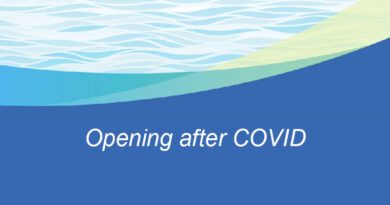WTTC lays out guidelines for a Safe and Seamless Travel in the ‘new normal’
The World Travel & Tourism Council (WTTC) has laid out its new guidelines Safe & Seamless Travel including testing and tracing, following medical evidence, to ensure people can enjoy Safe Travels in the ‘new normal’.
The guidelines will ensure that the travel sector is provided with an extensive framework to help governments and private businesses work in collaboration to create aligned testing and contact tracing programs.
The initiative is part of the WTTC’s Safe and Seamless Traveller Journey (SSTJ) which aims to enable a seamless, safe, and secure end-to-end traveler experience including flights and non-air travel.
It includes systematic biometric verified identification during the journey, for the long haul and international travel, replacing manual verifications, and is contained within a new WTTC report, published today.
Travelers and those who work in the Travel & Tourism sector can be assured of a more secure and safe environment, thanks to a leap in the use of contactless technology.
This includes biometrics, faster clearance for inbound and outbound passengers, and offsite processing as part of enhanced SSTJ capabilities which helps to reduce transmission.
The detection and isolation of those people with the virus have proved to be an effective mechanism to curb previous outbreaks. This has enabled them to travel again without a vaccine, as in previous outbreaks such as Ebola, SARS, and MERS. Since 80 % of COVID-19 carriers are asymptomatic according to medical experts, testing and tracing become crucial to control and reduce the transmission.
The new guidelines were produced by extensive consultation with various stakeholders, including WTTC Members, health experts, and government officials, and according to WHO and CDC guidance, and ICAO CART Take off guidance. WTTC in partnership with global management consultants, Oliver Wyman, conducted the consultations and produced this report.
The resulting principles and recommendations of the new guideline frameworks will help governments who require testing, tracing, receipt of a traveler test/vaccination certificate, and COVID-19 specific traveler health insurance to include them as part of their overall recovery plan.
By encouraging their global adoption, WTTC aims to ensure aligned and consistent messaging through coordinated, collaborative, and transparent partnerships across the Travel & Tourism sector.
They are also supported by medical fact-based evidence, as provided by multiple state governments and public health authorities such as the World Health Organisation (WHO) and US-based Centers for Disease Control and Prevention (CDC).
Gloria Guevara, WTTC President & CEO, said: “The safety and hygiene of travelers are paramount. This is why our new guidelines for Safe and Seamless Travel including testing and tracing, are designed to assist in the recovery of Travel & Tourism through the identification and/or isolation of infected travelers.
“This is consistent with advice from WHO and other leading health authorities that the best way to control and reduce the spread of the COVID-19 virus, is through early identification of carriers to ensure they don’t travel.
“The new WTTC guidelines mean that we can now replace the confusing mix of different measures including highly-damaging quarantines, which currently exist, to offer confidence to travelers and governments alike while protecting public health.
“Travel ‘bubbles’ or ‘corridors’ between low-risk COVID-19 areas/zones or countries will also help limit testing requirements for travelers and support efforts by governments and private businesses working in partnership together to stimulate traveler demand.
Dan Richards, Global Rescue CEO, said: “According to the Global Rescue survey of members, nearly 80% of travelers expect to return to the airways and roadways. Travelers are prepared to be tested, and 91% of people surveyed are willing to share personal medical history, and their travel plans as a pre-condition to returning to travel. They are willing and eager to help keep themselves and those around them safe.
WTTC identified five critical calls to action to governments during the COVID-19 recovery.
- Support quick and reliable tests as a critical path to ensure public health and a rapid testing and contact tracing strategy to help contain the spread of the virus
- Multilateral collaboration and adherence to internationally recognised guidelines to enable ‘approved travellers’ to travel across to multiple destinations using a single process and risk assessment framework
- Support travel ‘bubbles’ or ‘tourism corridors’ between low-risk COVID-19 areas/zones or countries based on recognised criteria on what constitutes low, medium and high risk and where the origin government and the destination government agree. These bubbles and corridors may help to limit testing requirements for travellers and support the recovery
- Remove blanket travel advisories and recommendations against non-essential international travel as this prevents insurance protection for travellers, as countries re-open
- Support a global standard of traveller health insurance, or at least minimum requirements, defined with private sector insurance companies
This latest WTTC initiative comes on the back of a series of measures designed to rebuild global consumer confidence and encourage the return of Safe Travels.
Safe Travels Protocols were developed for the global Travel & Tourism sector which focused on measures to drive business to car hire companies, airports, tour operators, attractions, short short-term rentals among many other travel sectors, to enable them to follow strict health and hygiene regimes to re-opening for business.
The welfare of travelers and the millions of people employed throughout the Travel & Tourism sector was at the heart of the protocols and were backed by the United Nations World Tourism Organization (UNWTO).
Evidence from WTTC’s Crisis Readiness report, which looked at 90 different types of crises, highlights the importance of public-private cooperation to ensure that smart policies and effective communities are in place to enable a more resilient Travel & Tourism sector.
According to WTTC’s 2020 Economic Impact Report, during 2019, Travel & Tourism was responsible for one in 10 jobs (330 million total), making a 10.3% contribution to global GDP and generating one in four of all new jobs



